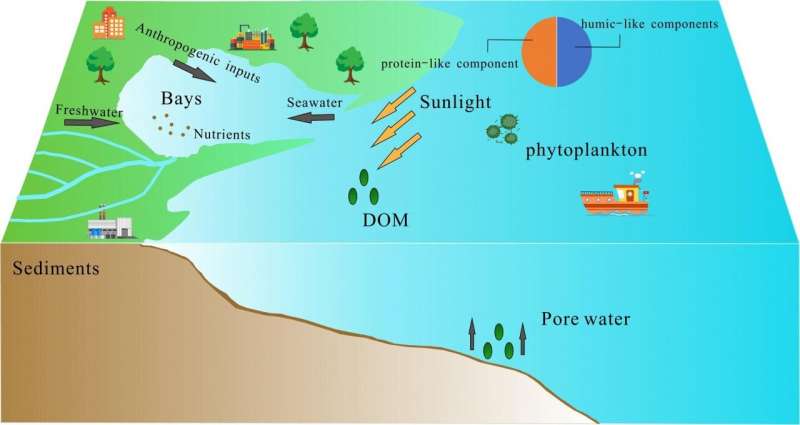Conceptual diagram of the dissolved organic matter pool. Credit: Science China Press
Coastal bays are momentous transition zones connecting terrestrial and marine ecosystems. Xiangshan Bay is a typically eutrophic and semi-enclosed bay in the East China Sea. A recent study took Xiangshan Bay as an example, revealing the sources and transformation of dissolved organic matter (DOM) in this eutrophic bay.
Dissolved organic matter (DOM), consisting of a vast collection of complex compounds, has received much attention due to its significant contribution to the largest reduced organic carbon pool in the ocean, which is sizable to the atmosphere CO2 reservoir.
Coastal bays are known for a semi-enclosed signature and a long water retention time compared, with river-dominated estuaries. In fact, they serve as links between rivers and oceans to transport organic carbon. However, they were universally exposed to high fluxes of nutrients from intensive anthropogenic activities such as sewage discharge and aquaculture industry due to their locations near human settlements. Large nutrient fluxes could lead to coastal eutrophication with harmful algal blooms, which have been observed in a couple of coastal bays, such as Jiaozhou Bay and Xiangshan Bay in China. The high primary productivity, as well as subsequent biogeochemical processes, induced from eutrophication might impact the chemical composition and flux of organic matter transported to the open ocean. As such, coastal bays are supposed to be not only "conduits" where organic matter is transported to open oceans, but also "reactors" where organic matter is processed or transformed.
Describing Xiangshan Bay as "one of the most valuable testing places around the world," researchers from Zhejiang University pointed out the immense value of investigating the compositions of the DOM pool there. "It is recognized as a typically long, narrow coastal bay, with long water retention time, which would facilitate the biogeochemical processing of organic matter. Furthermore, it has been the largest aquaculture base in Zhejiang province, causing severe eutrophication with harmful algae blooms."
Biogeochemical researches conducted in other coastal bays, since the emergence of the spectroscopic, have revealed "physical mixing, photo-oxidation, and tidal effects might affect the behaviors of DOM in such systems" according to Yu Pang and Chen Zhao, graduate students at the School of Earth Sciences, Zhejiang University, in the Chinese city of Hangzhou.
In an article coauthored with Yuping Zhou, Yanzhen Zhang, Wei Huang and Yuntao Wang, scholars at Zhejiang University and Second Institute of Oceanography, Ministry of Natural Resources, the researchers stated that "terrestrial, marine, and anthropogenic inputs collectively contribute to the whole DOM pool. The conclusion was confirmed by both optical and molecular approaches. One protein-like component and two humic-like components were identified by spectroscopic techniques and molecular groups associated with different sources were also determined."
These authors revealed in the study, which was published in the journal Science China: Earth Sciences, that terrestrial signals gradually decrease from the upper to lower bay with increasing salinity due to a seawater dilution effect while a protein-like fluorescent component may derive from multiple sources because a similar linear relationship is lacking.
Research aimed at solving this issue faced an array of obstacles: The isolation, extraction, and chemical characterization of DOM are prerequisites to understand its cycling in aquatic systems. However, except for a few sugars, amino acids, and lignin phenols, compositions of most DOM are still largely uncertain because of its complexity, heterogeneity, and low concentration in natural environments. Understanding the chemical composition and sources is a prerequisite to determine the DOM cycling in aquatic environments.
"Traditional techniques could only be reflective of the bulk chemistry of the DOM while our knowledge of the molecular-level composition of DOM is still lacking. To date, limited studies have combined optical and molecular approaches to systematically investigate the DOM composition in coastal bays."
To solve this problem, these researchers applied Fourier Transform Ion Cyclotron Resonance Mass Spectrometry (FT-ICRMS), a state-of-the-art tool offering a possibility to precisely obtain molecular-level information. In the recent years, scientists have established a variety of indices to depict DOM based on the data obtained from FT-ICRMS.
The researchers found that the physical mixing resulting from seawater dilution effect still occurs in Xiangshan Bay during summer, which has been widely found in river-dominated estuaries around the world. Also, the detection of anthropogenic-associated S-containing compounds confirms the inputs from human activities. Anthropogenic inputs may be a significant source of DOM in coastal bays when comparing Xiangshan Bay with other Chinese bays.
The data obtained from FT-ICRMS suggested that photo-induced degradation plays a critical role in altering DOM compositions, considering molecular compositions imprint pronounced labile signatures compared with other aquatic environments.
"To the best of our knowledge," wrote the seven researchers, "this work will also shed lights on future studies focusing on the estuarine carbon cycling."
More information: Chen Zhao et al, The optical and molecular signatures of DOM under the eutrophication status in a shallow, semi-enclosed coastal bay in southeast China, Science China Earth Sciences (2021). DOI: 10.1007/s11430-020-9728-4
Journal information: Science China Earth Sciences
Provided by Science China Press
























